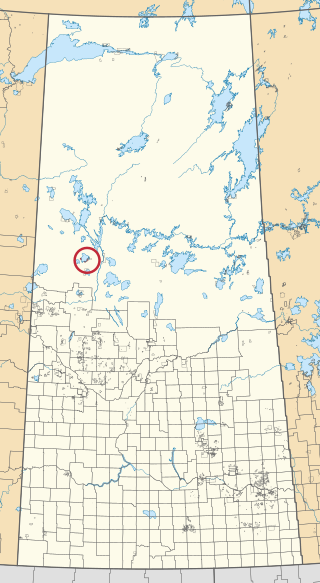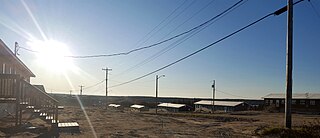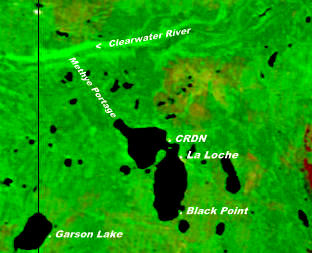Related Research Articles

The Cree are a North American Indigenous people. They live primarily in Canada, where they form one of the country's largest First Nations.

Fort Chipewyan, commonly referred to as Fort Chip, is a hamlet in northern Alberta, Canada, within the Regional Municipality (RM) of Wood Buffalo. It is located on the western tip of Lake Athabasca, adjacent to Wood Buffalo National Park, approximately 223 kilometres (139 mi) north of Fort McMurray.

The Chipewyan are a Dene Indigenous Canadian people of the Athabaskan language family, whose ancestors are identified with the Taltheilei Shale archaeological tradition. They are part of the Northern Athabascan group of peoples, and come from what is now Western Canada.
A tribal council is an association of First Nations bands in Canada, generally along regional, ethnic or linguistic lines.
First Nations in Alberta are a group of people who live in the Canadian province of Alberta. The First Nations are peoples recognized as Indigenous peoples or Plains Indians in Canada excluding the Inuit and the Métis. According to the 2011 Census, a population of 116,670 Albertans self-identified as First Nations. Specifically there were 96,730 First Nations people with registered Indian Status and 19,945 First Nations people without registered Indian Status. Alberta has the third largest First Nations population among the provinces and territories. From this total population, 47.3% of the population lives on an Indian reserve and the other 52.7% live in urban centres. According to the 2011 Census, the First Nations population in Edmonton totalled at 31,780, which is the second highest for any city in Canada. The First Nations population in Calgary, in reference to the 2011 Census, totalled at 17,040. There are 48 First Nations or "bands" in Alberta, belonging to nine different ethnic groups or "tribes" based on their ancestral languages.
The Chipewyan Prairie First Nation is a First Nations band government located in northeast Alberta south of Fort McMurray.
Red Sucker Lake is an Oji-Cree First Nation in Manitoba, Canada, located about 706 km (439 mi) northeast of Winnipeg. As of December 2014, the registered population was 1,067 of which 930 lived on their own reserve.
The Athabasca Chipewyan First Nation is a band government. It represents local people of the Denesuline (Chipewyan) ethnic group. It controls eight Indian reserves: Chipewyan 201 and Chipewyan 201A through Chipewyan 201G, near Fort Chipewyan, Alberta. The band is party to Treaty 8, and is a member of the Athabasca Tribal Council.

Canoe Lake 165 is an Indian reserve of the Canoe Lake Cree First Nation in the boreal forest of northern Saskatchewan, Canada. Its location is on Canoe Lake approximately thirty miles west of Beauval, within the ancient hunting grounds of the Woodland Cree. In the 2016 Canadian Census, it recorded a population of 912 living in 250 of its 273 total private dwellings. In the same year, its Community Well-Being index was calculated at 53 of 100, compared to 58.4 for the average First Nations community and 77.5 for the average non-Indigenous community. The reserve includes the settlement of Canoe Narrows. The name of the reserve and the settlement in Cree is nêhiyaw-wapâsihk ᓀᐦᐃᔭᐤ ᐘᐹᓯᕽ.
Fort McMurray First Nation is a Cree and Chipewyan band government located near Fort McMurray, Alberta. It is a member of the Athabasca Tribal Council and a Treaty 8 nation. The Athabasca Tribal Council represents 5 First Nation bands in northeast Alberta. Fort McMurray First Nation is governed by a Chief and two councillors.

The Fort McKay First Nation (FMFN) is a First Nations government in northeast Alberta comprising five Indian reserves – Fort McKay 174, Fort McKay 174C, Fort McKay 174D, Namur Lake 174B and Namur River 174A. The FMFN, signed to Treaty 8, is affiliated with the Athabasca Tribal Council and its members are of Cree, Metis and Dene heritage. The FMFN's traditional lands include portions of the Athabasca oil sands.
Cross Lake First Nation is a band of Cree First Nations people in Canada governed under the Indian Act. Its members occupy several reserves within the town of Cross Lake situated on the east shore of Cross Lake in the province of Manitoba. In October 2008, its recorded registered membership was 6,969, of which 4,953 people of this First Nation lived on their reserve. Cross Lake is the principal community of the Pimicikamak indigenous people that made treaty with the British Crown in 1875. Its indigenous language is Woods Cree. Cross Lake was the site of a residential school operated under Canada's assimilation policy. In 2008, Prime Minister Stephen Harper apologized for the damage caused by this policy.

Allison Bay 219 is an Indian reserve of the Mikisew Cree First Nation in Alberta, located within Regional Municipality of Wood Buffalo. It is 3 kilometers northeast of Fort Chipewyan. In the 2016 Canadian Census, it recorded a population of 127 living in 38 of its 46 total private dwellings.

Devil's Gate 220 is a First Nation reserve of the Mikisew Cree First Nation in Alberta, located within the Regional Municipality of Wood Buffalo. It is 10 kilometers north of Fort Chipewyan.

Marcel Colomb First Nation (MCFN), Band #328, is a First Nations Band of approximately 449 Registered Swampy Cree and Rocky Cree (Asinīskāwiyiniwak) located in the area of Lynn Lake, Manitoba, Canada. Marcel Colomb First Nation is affiliated with the Swampy Cree Tribal Council.

The Clearwater River Dene Nation is a Dene First Nations band government in the boreal forest area of northern Saskatchewan, Canada. It maintains offices in the village of Clearwater River situated on the eastern shore of Lac La Loche. The Clearwater River Dene Nation reserve of Clearwater River shares its southern border with the village of La Loche.
The Prince Albert Grand Council (PAGC) is a Tribal Council representing the band governments of twelve First Nations in the province of Saskatchewan. Its head offices are located in the city of Prince Albert. The Tribal Council was created in 1977 and is one of the largest in Canada.

Mikisew Cree First Nation is an Indigenous First Nations government of Woodland Cree people in northeastern Alberta and in Northwest Territories, Canada.

Jim Boucher is a Cree and Dene Indigenous Canadian businessman and political leader. As an elected chief, he represented the Fort McKay First Nation (FMFN),. He established the Fort McKay Group of Companies in 1986, and continued to be chairman and president of the Fort McKay Group of Companies (1986–2019), president of the Athabasca Tribal Council (ATC), grand chief of Treaty 8 First Nations of Alberta, vice-chairperson, Board of Governors of Keyano College in Fort McMurray, Alberta, and chairperson for the National Aboriginal Economic Development Board.
References
- ↑ "AANDC (Athabasca Chipewyan First Nation)". Crown–Indigenous Relations and Northern Affairs Canada . Government of Canada. Retrieved 2016-09-26.
- ↑ "AANDC (Fort McKay First Nation)". Crown–Indigenous Relations and Northern Affairs Canada . Government of Canada. Retrieved 2016-09-26.
- ↑ "AANDC (Chipewyan Prairie First Nation)". Crown–Indigenous Relations and Northern Affairs Canada . Government of Canada. Retrieved 2016-09-26.
- ↑ "AANDC (Fort McMurray #468 First Nation)". Crown–Indigenous Relations and Northern Affairs Canada . Government of Canada. Retrieved 2016-09-26.
- ↑ "AANDC (Mikisew Cree First Nation)". Crown–Indigenous Relations and Northern Affairs Canada . Government of Canada. Retrieved 2016-09-26.